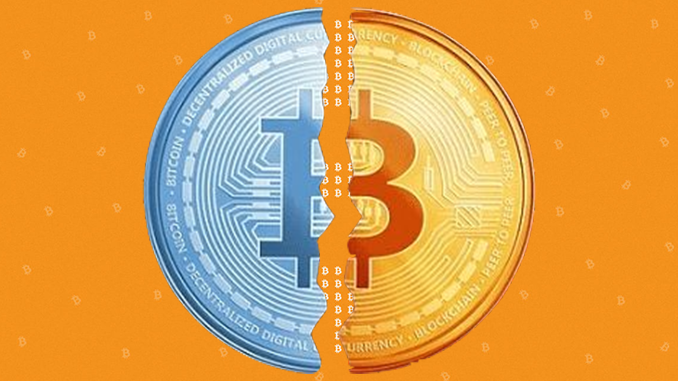
Bitcoin Halving, which is due on 12 May 2020, employs investors worldwide. How does BTC’s share price develop before and after the event? Technologically speaking, however, Bitcoin Halving is not very spectacular.
Many analysts are already trying to see the signs of the Bitcoin Halving due on May 12, 2020 from the recent swings in the price of Bitcoin (BTC). And indeed, the history of Bitcoin around the two halvings that have already taken place in 2012 and 2016 has proven that this automated event will have a significant, and generally positive, impact on the price of BTC. So what is the technology behind Bitcoin Halving and why has it been firmly anchored in BTC’s code?
Briefly explained: Bitcoin Halving
In the original whitepaper on BTC, the mysterious and still anonymous Satoshi Nakamoto had not even mentioned a Bitcoin Halving. This detail he added only a little later in a message to BTC pioneers, it can be read about here. Nakamoto explained that in the code of Bitcoin a halving was cemented, which should take place every four years. To increase the attractiveness of Bitcoin in the beginning and to encourage as many users as possible to operate nodes, 10.5 million BTCs were reserved as a reward for the development of new blocks in the block chain. For each new block built between 2008 and 2012, there were 50 BTCs at that time. A new block records transactions irrevocably and tamper-proof, the block chain is the incorruptible entity that technologically protects BTC from political or human influence.
Satoshi Nakamoto had set the maximum number of all BTCs at 21 million and assumed that BTC would find more and more followers. Hence the halving, which slows down inflation. In 2012, with the first Bitcoin Halving, the reward was halved to 25 BTC per block and 5.25 million BTC were reserved for the period until 2016. The game was repeated in 2016 with 12.5 BTC as the reward factor and 2.625 million Bitcoin reserved. With the current Bitcoin Halving, the reward drops to 6.25 BTC per block, and 1,312,500 BTC are reserved for it until 2024. This spiral continues until once every 21 million maximum BTC is almost reached and nodes have to be satisfied with transaction fees, but new BTCs are only created in microscopic doses.
Bitcoin Halving, gold and monetary policy
Satoshi Nakamoto wanted to create a hard digital currency whose value would be decided on the free market and which would escape other influences. Historically, such a store of value has already established itself globally with gold. Deposits are limited, making it increasingly difficult to tap new sources of gold, and at the same time gold is accepted worldwide as a currency substitute. Under this premise (“stock-to-flow concept”), experts at German Bayerische Landesbank, for example, arrive at a market value for Bitcoin of USD 90,000 in 2020 after halving in the regions. One thing is clear: Monetary politicians can still swear and old financial stars like Warren Buffett can still swear Demonize BTC – they can’t change the code of Bitcoin.
And Satoshi Nakamoto had also foreseen a second scenario in connection with Bitcoin Halving. Because if the reward for new blocks drops, Miners could give up their business, just as not every gold mine is exploited down to the last morsel. But in such cases, if the hashrate in BTC’s block chain drops significantly, i.e. the number of blows in the gold mines – what happens then? Then BTC’s code automatically adjusts the difficulty of finding new blocks downwards, making this performance more profitable again until the performance of the block chain again reaches the level required by the market. Then the difficulty is increased again and so on. Here, Bitcoin’s code contains a second stroke of genius that cannot be levered out from the outside and ensures that BTC’s block chain functions stably.
Conclusion: Bitcoin Halving technologically a small step with potentially enormous consequences
When the Bitcoin Halving is triggered on 12 May with block 630,000 in the block chain of BTC, only a few numbers change in the code. That’s for sure. Will the assumption of optimistic investors be confirmed that BTC Halving will boost the price? They assume that the demand for BTC will continue to rise while new supply will become scarcer. This thesis has proven to be correct for the previous Bitcoin Halvings with a time lag and has already driven BTC to new all-time highs twice.
There is much to suggest that this history will be repeated, not least the enormous inflationary dangers in Fiat through the times of the Corona crisis. When the money printing machines of central banks around the world are fired up for economic stimulus programs, the inflation risk of key currencies such as the US dollar or Europe increases, while BTC, as a store of value with Bitcoin Halving, holds out against it regardless of such developments. On the other hand, we should not forget: The highly logical approach of Bitcoin with Halving is still in the young adult phase over a longer period of time, and gold has a much longer history compared to this.
Best place to buy Bitcoin:

Leave a Reply